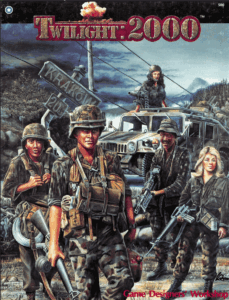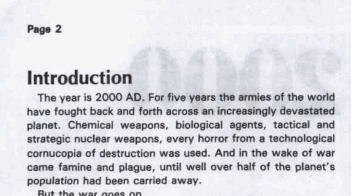Twilight 2000
Twilight 2000
Because Everything Old Is New Again
Unfortunately
A few months ago, I got some mileage (well, more like yardage, given the quality of my jokes) out of the hi-lair-ious certainty that the Russkies would start WW3 leading to post apocalyptic fun tragedy. That, as the kids say, aged poorly. Which is what a lot of people said about early-80s “mid-pocalypse” game, Twilight 2000. Published in 1984 and set in the unimaginable far future of 2000, it took place  in a world where a “limited” nuclear exchange had shattered nations but not quite blasted everything back to the stone age. Then the Berlin Wall came down and despite numerous revisions and attempts to update, it inevitably felt dated in a world of “asymmetric warfare” and “leaderless resistance”.
in a world where a “limited” nuclear exchange had shattered nations but not quite blasted everything back to the stone age. Then the Berlin Wall came down and despite numerous revisions and attempts to update, it inevitably felt dated in a world of “asymmetric warfare” and “leaderless resistance”.
Well, hoody-hoo! Thanks to Putin and his dreams of becoming Stalin II: The Wrath of Marx, we finally have the existential threat of incoming ICBMs from a clearly identified national enemy! So it’s time to go back to the future that never was — but might yet be — and do a chargen walkthrough of Twilight 2000, before the nukes drop and there’s no more Internet.
Note: I could have sworn I owned a copy of the boxed set, but I couldn’t find it, so I purchased a PDF from Drive-Thru. With all due respect to GDW, it looks like they just hacked this out as quickly as they could feed pages into a cheap scanner. No bookmarks, and the scan shows the other side of the page.
Be that as it may, my money is spent, and so, I must write this article.
How It All Fell Apart
The usual suspects: NBC (nuclear, biological, chemical) war, communication breakdown, infrastructure collapse. It all began in 1995, so after five years of everything going bad, the military had virtually become its own nation, with the last operation pre-game being an attempt to secure farmland and fisheries, simply to keep alive. That effort failed when the Soviets pushed through (as Ukraine was still part of the USSR in this game’s reality, we couldn’t rely on Ukrainian farmers to steal the tanks from them), and, well…
As division headquarters was being overrun, the CO’s last radio message was, “You’re on
your own. Good luck.”
Gotta admit, that sets the tone of the game beautifully. I can picture myself reading that to the players just before chargen, to set the mood. It’s grim. There’s no mission anymore, no way to get home (if it’s still there), no cause to fight for except the one you choose for yourself, no family or nation besides the men and women by your side.
In other words, it’s a totally awesome setting for a game! Let’s frag some Russkies! WOLVERRRINES!!!!
Cough. Ahem. Sorry, a bit of the 80s got caught in my throat. Where was I?
Ah, yes. Character creation.
Name, Rank, and Serial Number
The base set assumes you’re a survivor of the Fifth Mechanized Infantry, and then steps through the character creation process. One of the things I like about the rules is how they use a paragraph or two of in-character text to introduce each successive chunk of rules. It builds the mood and gives you a feel for the setting and tone, without hitting you with page after page of backstory and self-indulgent gibberish. We begin, of course, with attributes. (Well, I say ‘of course’ despite having dealt with, ahem, some other games that begin in the middle and then loop around, Jeremy Bearimy style.)
Rolls are 4d6-4, giving a 0 to 20 bell curve. I assume this was done to provide an easy way to use stats against a D20 roll. (You can reroll any results of zero.) I suppose we’ll find out later. Attributes are pretty standard for the time, no ‘Chorus’ or ‘Refulgence’.
Fitness: Used to determine strength in proportion to size when combined with stature, then, you throw away fitness and just use Strength. Uhm. OK. Anyway, it’s 11.
Agility:10
Constitution: 7 See, this is why I prefer point based systems.
Stature: 13
Intelligence: 12
Education: 14
As you might expect w/a 4d6 bell curve, most are clustered near the average of 10 (counting the -4 modifier). The 14 isn’t too bad, indicating a college graduate but not a Masters. There’s no correlation between intelligence and education, a fact I consider quite realistic. (See also Classic Traveller.)
And I rolled too fast: I had a chance to ‘favor’ attributes, rounding the chosen ones up to midway between the roll and 20, but for each such picked, I would have had to disfavor another, rounding it down to between the roll and 0. Since this was optional, I’ll just stick with the unmodified rolls. The system does allow you to somewhat control the dice to shape the character you want to play, but a run of bad luck (and is there any other kind?) might still do you in.
Total: 67. This is used later, they say.
Now is when I calculate Strength, by averaging Fitness and Stature: 12.
Hit Capacity: Like many systems of this era (and earlier, back to Runequest, and forward, to Godlike), you divide your hit points by body parts.
Head: 7 (based on Con. Owie.)
Torso: 32 (Str + Con + Stat)
All other (Arms and Legs): 20 (Con + Stat)
Weight: 92kg, or 21,576 zolotniks.
Load: 32kg, or 16.2 stone.
Throw Range: 24 meters, or 8.74 reeds.
Now we get to military experience, which is based on 120 minus the attribute total (67), then dividing by 7: 7 (rounded down)
(I can hear the “D&D 5e has sooooo much maaaath! It’s haaard!” crowd entering fetal position already.)
Time in combat, in months, is based on rolling 1d6 for each point of base military experience, or, 7d6: 26 months.
Totally Rad!
Well, I Hope Not, Actually
Still more derived/calculated stats! (This actually is useful in that it helps give some hints of your backstory, a bit.)
Coolness Under Fire, aka, your chances of shrieking ‘Game over, man! Game over!’: Time in combat/10 (2) + 1d6 (2) = 4. Which I subtract from 10, leaving 6. Which is evidently “Not cool, dude.”
Rads: Roll a d6 for each point of military base, so, 7d6: 18 rads. This will “influence [my] willingness to take risks in potentially contaminated areas”. Well, I’m staying out of New Jersey, that’s for damn sure.
Age: Divide months in combat by 12, rounding up. So that’s 3. Then add EDU (14) to equal 17, plus 8 (hard-coded), so 23. As my months in combat is under 49, I add 1d6. I roll a 5, thus I’m 28.
Starting to get some image of him. Educated but not the healthiest, he probably signed up expecting a cushy tech support job far from the front.. but the front has a tendency to move. Or he may have been called into Europe to do maintenance on key weapons systems, then found his ride home was blown to pieces, as was, well, his home. We’re definitely getting a few rough starting points to make an actual character, here.
Rank: Well, yeah, I guess I am, showering isn’t a priority right now. Oh, military rank! That’s 2d6 + 16, and if it’s less than Int + Edu, I am an officer. My total is 22, my Int + Edu is 26, so, you can call me Sir! Maybe. I’m on the right side of the divide, but how far? Time in combat divided by 10 is 2. Roll 1d6 – got a 5, which adds 1 to my rank, which is 3, which means… uh.. consult the table… what table??? Oh, the table which, in the original boxed set, was conveniently printed out in a player’s booklet, but which in the PDF is in a locked filing cabinet in a disused lavatory with a sign on the door reading ‘Beware of the Russian’. It says I’m a Captain.
Nationality: This is up to the player. You can choose to be American or European, and as all of the armies have picked up deserters, you can be from an ‘enemy’ country. The default is that your unit is still technically under American command, and the highest ranking American is in charge, as God, John Wayne, and Ronald Reagan intended. So I’ll stick with that, I figure he joined the military for the education benefits and barely scraped by on the physical requirements, but managed to get through OCS and maybe earned a field promotion or two from jury-rigging some equipment and saving everyone’s bacon. (Hopefully, the skills will let me fit that concept.)
Languages: I speak American. Who needs to speak anything else ? Well, there’s a slim chance I might know another language, but, no.
Service Branch: T2K borrows a little from Traveller, in that I need to roll to see if I can make it into my desired branch. Combat engineer is Right Out, due to my Con of 7 — minimum 12 to even try. But “ADM Specialist”, which some Googling indicates means “Atomic Demolitions/Munitions” (It says something about their target audience they felt no need to include a glossary of all the TLAs used.) requires Int, which I just barely manage. And I made the 6+ roll! So I am qualified to disarm nukes! Yay… me?
Coming up next: Skills!
Oh, I need a name, don’t I? Quickly, Robin! To the Randomizer!
Nathan Tyler looks good. Well, Captain Tyler, next time, we’ll see if you can actually do what your rough-edged character concept suggests.


Bringing back memories !
Pingback:Twilight 2000 Part 2 – Lizard's Gaming and Geekery Site